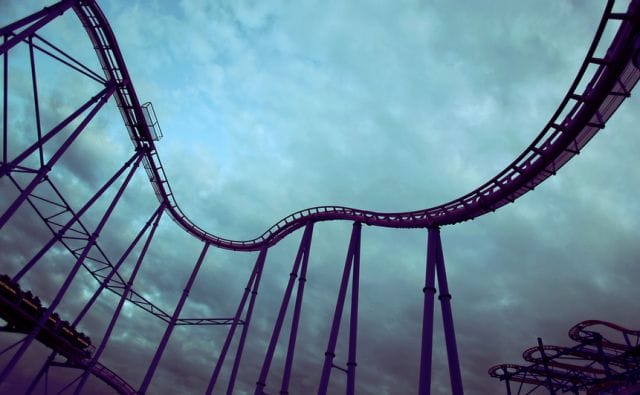“A good roller coaster is better than sex.”
(Michael Quinn, Letters to the Editor: Oui magazine, January 1978)
![]()
Perhaps no other creation in history has navigated the divide between terror and unadulterated joy as skillfully as the roller coaster.
Since these “scream machines” were introduced nearly 250 years ago, they have brought millions to tears in all capacities. As one roller coaster designer told us, anonymously: “My job is basically to get as close to making people poop their pants as possible, then have them step off in ecstasy and want to go again.”
But the history of roller coasters has been rockier than its rickety tracks: immensely popular in the 1920s, they endured a near-death experience during the Great Depression; titans and tycoons watched fortunes crumble with the splintered rubble of their amusement rides. Then, in the second half of the century, coasters victoriously rose from the ashes stronger, bigger, and faster than ever before.
Today, the industry enjoys measured success: according to Roller Coaster Database, there are 2,956 roller coasters in 2,067 amusement parks worldwide, with nearly 400 million riders each year. How did these feats of engineering become so popular, and who are the people behind them?
A History of Ups and Downs

Source: Library of Congress
The earliest predecessor of the roller coaster dates back to 17th century Russia, where giant hills of ice were specially constructed into winter sled rides called “Russian Mountains.” Passengers would ascend a 70-foot timber tower, then rocket down a 600-foot ice ramp — typically set at a 50 degree slope, and supported by wooden beams — on nothing more than a small sled. Initially, the rides were only enjoyed by the gentry, as a winter sport.
Catherine the Great, who visited the Russian Mountains in St. Petersburg in the mid-1700s, was so taken by the ride that she ordered a summer-compatible version to be designed and built at Oranienbaum, her private residence. In lieu of ice and sleds, her quasi coater, Katalnaya Gorka, featured rudimentary wheeled carts placed on grooved tracks.
The immense popularity of the ride piqued the interest of European entrepreneurs. In 1812, the French built their own model, Les Montagnes Russes (“The Russian Mountains”), which featured guided tracks; this was followed by Promenades Aeriennes (“Aerial Walks”) in 1817, the first ride to have wheels securely locked to the track, and guide rails to keep the carts on course.
The French pioneered many advancements in early roller coasters, including the first loop in 1846. The car was said to have traveled through the 13-foot loop at “150 miles per hour” (a highly dubious claim), with “nothing more than centrifugal force” holding it to the track; it was tested using sandbags, eggs, monkeys, and one lucky worker, whose experience was recorded in France’s Journal du Havre:
“Starting from the highest point, he reached, in eight seconds, the extremity of two hundred and forty-eight feet. On landing, he appeared very satisfied with his journey. Going upgrade, he had clapped his hands as he ascended…and during the loop proper, experienced such a delicious feeling that he wanted to try again.”
While roller coasters took off in Europe, they were just getting underway in the United States, and in a much less intentional fashion.
![]()
In 1791, a major coal site discovered in Summit Hill, Pennsylvania inadvertently introduced roller coasters to the United States. Initially, bulk product was transported by pack-mule, and entailed traveling over exposed mountain terrain over the course of multiple days. Lehigh Coal & Navigation Company, who was in charge of the operation, was having only sporadic success getting coal to industrialists in Philadelphia and realized they had to adapt.
So, in 1827, they constructed The Mauch Chunk Switchback Railway — the second ever one-way gravity railroad in the U.S. — which sent anthracite from company mines at Summit Hill down to the coal chutes in Mauch Chunk. Initially, the downhill journey was covered in 30 minutes, but getting the 4-ton cars back up required a grueling four-hour mule trek.
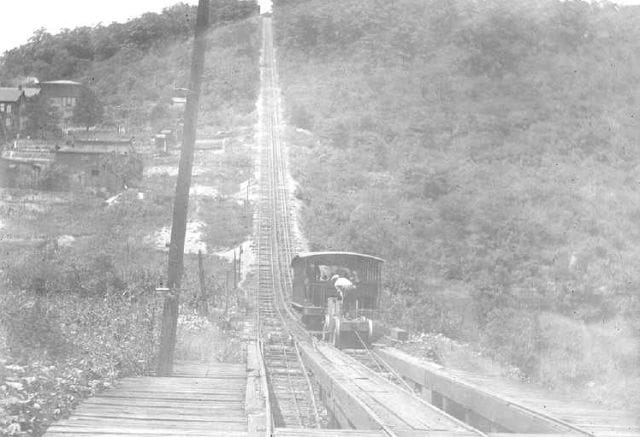
Mauch Chunk Switchback Railway near Summit Hill, Pennsylvania (1846)
Nonetheless, the rail soon became a weekend travel destination for the upper-class, who would pay 50 cents to descend the “somewhat exciting” five-mile track. The railway became so immensely popular with tourists that by 1829, coal was only transported in the morning; the rest of the day would be dedicated to leisure rides. Mauch Chunk was even frequented by President Ulysses S. Grant and Thomas Edison.
By 1846, the company had developed a ratchet system that, in conjunction with a steam-powered funicular system, assisted in pulling the cars back up the hills. This technology would be developed into an anti-rollback device used in roller coasters.
Building on this concept, LaMarcus Adna Thompson, a preacher and budding capitalist from Ohio, became the world’s first roller coaster tycoon. He recognized the potential in entertainment-based rail cars and, in 1881, erected Switchback Railway in New York’s Coney Island — the first “roller coaster” designed and built for amusement in the United States. He fancied his own ride, likening it to the “sunshine that glows bright in the afterthought and scatters the darkness of the tenement for a nickel or a dime.”
Indeed, riders would pay five cents to scale a high tower and board a “bench-like” car; they’d then be pushed down a 600-foot track to the base of an opposing tower (similar to the “Russian Mountains” of 17th century St. Petersburg). The ride was so immensely popular that it paid itself off in 3 weeks’ time.
Thompson’s ambitions led to the first complete-circuit coaster (1884), and the first coaster with a lift system and forward-facing cars (1885). In 1886, Thompson patented his roller coaster design methodology, and constructed a series of over 50 coasters across America throughout the early 1900s.
Historian Judith Adams writes about the cultural impact of Thompson’s coasters:
“They combined an appearance of danger with actual safety, thrilled riders with exhilarating speed, and allowed the public to intimately experience the Industrial Revolution’s new technologies of gears, steel, and dazzling electric lights.”
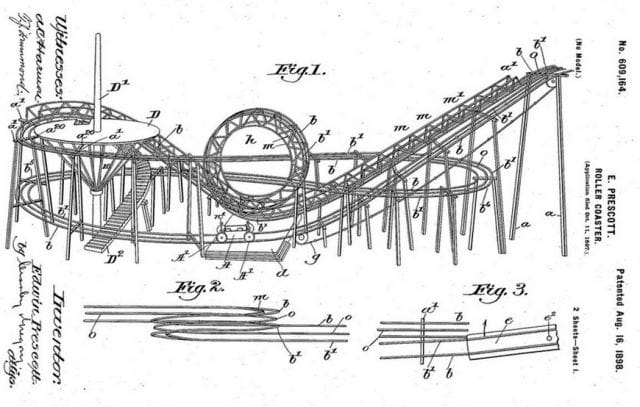
An early patent for improved roller coaster design, 1898; Source: Google Patents
John Miller, considered to be “the father of the modern high-speed roller coaster,” used Thompson’s ideas to develop the under-friction component (a wheel that runs under the track and keeps cars fixed) in 1919. This was not only a breakthrough in safety, but opened up a floodgate of possibilities for designers: they could now make their coasters operate at higher speeds, with steeper drops and sharper horizontal turns.
Speed, boldness, and recklessness defined the age of invention in the 1920s: throughout the decade, roller coasters experienced a golden age, with nearly 2,000 built in a ten-year span. The Cyclone, built to replace the Switchback Railway in Coney Island, was among the period’s most iconic coasters. Built in 1927 with $175,000 ($2.3 million in 2014 dollars), the coaster was 25 cents to ride and saw nearly 1,400 riders an hour at its peak operation.
Abruptly, this “golden age” ended with the Great Depression, during which amusement parks nearly died out entirely. Hundreds of coasters built from 1890-1930 met the fate of the wrecking ball: by 1965, only about 200 of the 2,000 coasters built through the 1920s were still in operation.
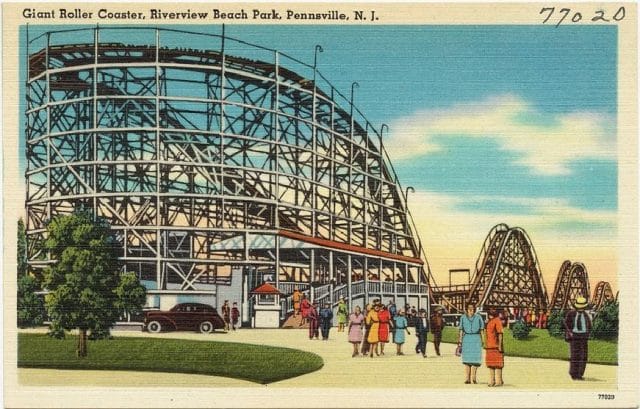
Source: Boston Public Library
By 1960, the roller coaster industry was at an all-time low.
But there was promise on the horizon: the economy was recovering, and Baby Boomers had more money to spend on leisure. Disneyland, which had just opened in 1955, turned to roller coaster design company Arrow Dynamics, Inc. to design a groundbreaking coaster for their park. What resulted, in 1959, was the Matterhorn — the world’s first coaster constructed with tubular steel and nylon-coated wheels. It perennially changed the landscape of roller coaster design.
A few years later, one of the most well-known roller coaster designers, John C. Allen, ignited the revival of roller coasters. He had seen his heyday in the 1920s and 1930s, and was set to retire when he met Gary Wachs, the owner of Coney Island, in 1968. Wachs convinced Allen to “go out with a bang,” and design one more coaster; Allen agreed. Allen, who had worked for the Philadelphia Toboggan Company and worked solely with wood, felt there was still room for innovation with wood coasters.
When his 1972 creation, The Racer, was erected at Kings Island in Mason, Ohio, it did more than serve as an exit to Allen’s career: it sparked the “second golden age” of roller coasters. The coaster, featuring two side-by-side trains which “raced” against each other, appeared on The Brady Bunch in 1973, and developed a cult following. One designer called it “a theme park’s dream: a work of art and a thrill ride all at once.” Through the 1980s, The Racer was showered with media attention; one rider, Don Helbig, famously set out to ride it 1,200 times during one summer (he has ridden the coaster 12,000 times since).
From 1974-1980, riding on the success of The Racer, roller coasters experienced a revival, with more being constructed than every previous year combined since the 1920s. Steel coasters, armed with new technology, began to almost entirely dominate the roller coaster space.
Going Giga: A New Era of Coasters
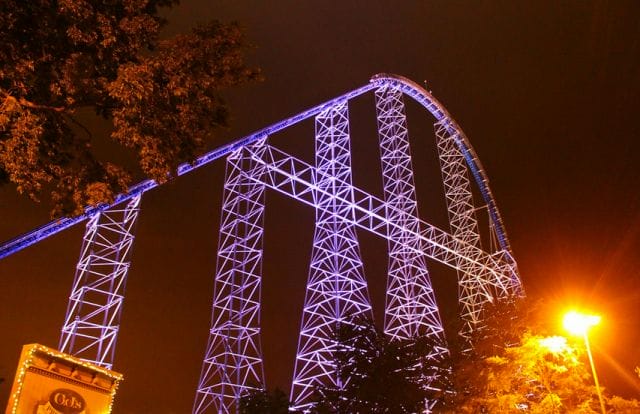
In the advancement of steel roller coaster design in the 1970s, Ron Toomer was a pioneer. After earning a mechanical engineering degree in 1961, he became involved with the very first U.S. satellite launches, then joined NASA and designed heat shields for Project Apollo (his design would later be used on Apollo 11, the first spacecraft to land on the moon). But in 1965, he left NASA, joined amusement ride company Arrow Dynamics Inc, and began a 30-year career as a roller coaster designer.
Toomer continued to forge new ground: in 1966, with a $1 million budget, he designed the all-steel Runaway Mine Train, at Six Flags Over Texas. His creation was named a National Landmark by American Coaster Enthusiasts (ACE), and organization which had this to say about Toomer and his design:
“By combining clever inversions with impressive heights, he helped advance the steel coaster prominently into the 21st century…[Runaway Mine Train] not only has a place in history but in the hearts as park guests as well.”
In 1975, he built “Corkscrew,” widely regarded as the first inverting coaster of the modern era, at Knott’s Berry Farm in California. His design began merely as a prototype, but members of the Knott family enjoyed the prototype so much that they purchased it on the spot. Toomer’s Big Bad Wolf, built in 1984, was the first “successful” suspended coaster (though King Island’s plagued coaster, The Bat, preceded it in 1981); five years later, his Magnum XL-200 design was the first to ever top 200 feet in height (known today as a “hypercoaster”).

Source: Manohar Darasi
But as storied as Ron Toomer was (he passed away in 2011), he rarely rode his own inventions. “I’ve had a bad motion sickness problem since I was a little kid,” he told American Coaster Enthusiasts. “But I’ve ridden enough of them to know what happens and how it feels.” Toomer was such a visionary in roller coaster design that he was named one of Britannica’s “100 Most Influential Inventors of All Time,” alongside the likes of Eli Whitney, Henry Ford, and Steve Jobs.
His coasters, combined with the advent of inexpensive microprocessors and hydraulic technology, paved way for the hypercoasters and giga-coasters of the 1990s. Kent Seko, a veteran designer at Arrow Dynamics, recalls the era being a “height war,” where parks and manufacturers competed to create the biggest, fastest, tallest coasters in the world.
Through the decade a series of benchmarks were set: Batman The Ride (Six Flags Great America, Illinois) was the first inverted coaster; Superman The Escape (Six Flags Magic Mountain, California) featured a 400 foot free-fall, and speeds of nearly 100 miles per hour; Japan’s Steel Dragon 2000 boasted an incredible 8,133 feet of track. Records were set, only to be broken weeks later: it was a battle of roller coaster titans, much to the chagrin of eager riders around the world.
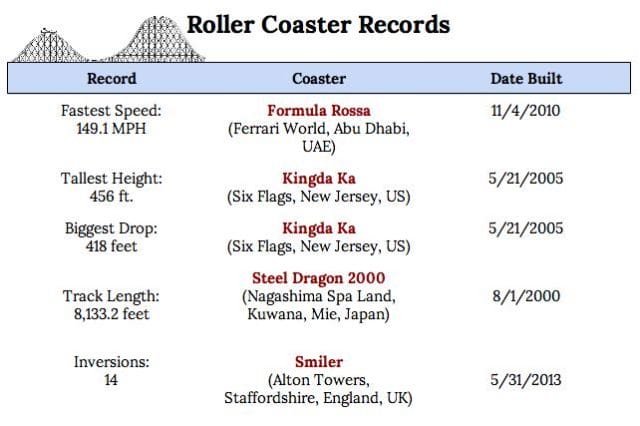
Zachary Crockett; Stats via RCDB
In 2000, the concept of the “giga-coaster” debuted: Millennium Force, created by coaster legend Werner Stengel, was the first complete-circuit coaster to top 300 feet in height, and featured a first drop slope of 80 degrees. Just three years after its release, Top Thrill Dragster became the world’s first 400-foot complete-circuit coaster. In less than 4 seconds, riders would be launched to speeds of 120 miles per hour and shot over a 90-degree hill. Six Flags soon answered with Kingda Ka, a 456-foot beast.
![]()
Coaster technology is constantly evolving. Today, many of the fastest modern coasters use electromagnet technology and powerful linear-induction motors to generate a magnetic wave and propel cars down the track. Jim Seay, President of Premier Rides, says the vehicles “have very lightweight, high-conductivity fins on them,” and that, when in use, it is as if the coaster’s cars are “surfing a traveling magnetic wave.”
In the future, Seay says coasters could utilize this approach to magnetically levitate on the track; this “maglev” technology is also touted as the future of high-speed light rails. If this tech panned out, it would result in a completely frictionless ride — no bumps, no hitches, and no noise like today’s coasters.
Today, every record-setting coaster is less than 15 years old. The industry has come back to life from its near death in the 1950s, and a new “Golden Age” has spawned.
Real-Life Roller Coaster Tycoons
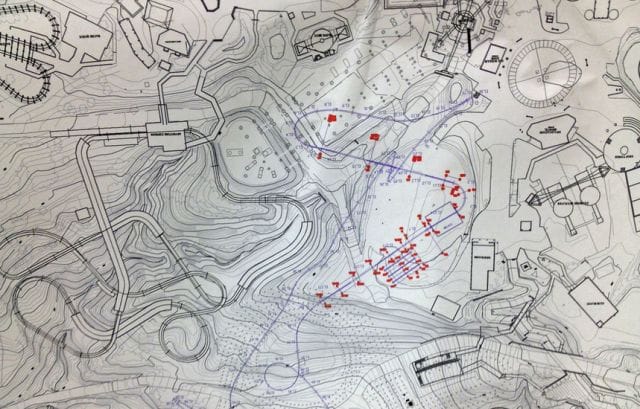
Blueprint for a new coaster in Mason, Ohio; Source: Rachel Richardson
John C. Allen (the roller coaster designer who, in part, brought coasters back to prominence in the 1970s) once famously joked, “You don’t need a degree in engineering to design roller coasters, you need a degree in psychology.” Needless to say, this simply isn’t true.
Building a roller coaster is a massive undertaking that involves astute project managers and some of the best structural/mechanical/electrical engineers in the country. Getting a job in this industry is extremely competitive: there are just 100 roller coaster firms in the United States, most of which employ small, highly specialized teams of 10-15 people.
Most roller coaster designers are engineers, and those who aren’t possess many of the same skills as one: sharp mathematical prowess, attention to detail, and a true passion for physics. Engineer Glenn Birket says he spends more than half his time working on safety issues. “It’s not the part that you think of first,” he says. “It’s maybe the part that you think of after you’ve thought a little harder about roller-coasters.” Designer Mike Boodley adds that he and his colleagues often “give their lives over to the project” — for a median salary of around $74,600, according to McGraw-Hill.
Eamon Kelly, a project engineer with Baltimore-based Premier Rides, grew up playing Roller Coaster Tycoon (the massively popular game in which the player designs her own roller coasters); now, he’s a “real life roller coaster designer.” He explains the process for us.
Typically, he says, a job starts with an amusement park deciding what kind of coaster they want (steel, wood, etc.); once this is determined, they’ll send out a general concept to various roller coaster manufacturing companies, who put in bids. This initial concept has a wide variance: sometimes a park will submit a vague idea, and other times, it will have a 50-page, detailed guideline of exactly what they expect.
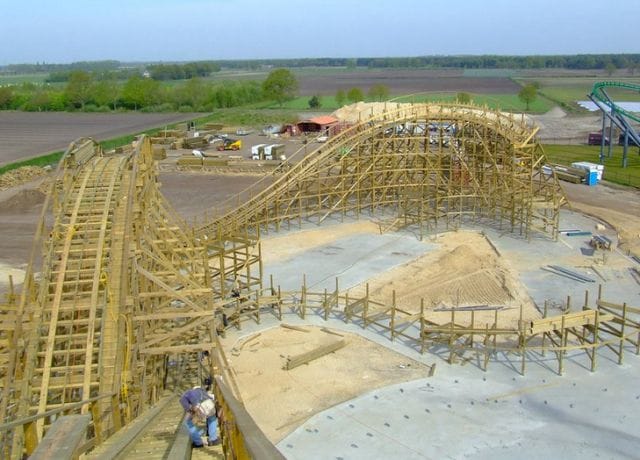
Troy, a coaster in Toverland, underway in 2007; Source: GCI
Once a manufacturer is contracted, it works together with the park to develop a design. The park must submit a multitude of information — soil and wind conditions, topography, ground density — to influence the design. The design process utilizes 3D modeling programs like Inventor and SolidWorks; for marketing, 3DStudioMax and NoLimits are used, the latter of which Kelly calls a “grown-up version of Roller Coaster Tycoon.”
Once the design is submitted and construction is set, components can take up to month to ship by sea (since it’s such a small industry, parts often must be purchased internationally).
Kelly says engineering is steeped in every aspect of this process:
“A [coaster] engineer can appear in pretty much any part of the process. Some are structural and analyze how the wind/soil conditions affect the strength of the supports, some are electrical and design and install the controls systems, and some are mechanical and design parts of the vehicles and wayside equipment (things like brakes and chains/lift systems).”
As a project engineer, Kelly is involved with designing the coaster’s initial layout and estimating its cost. He says a coaster’s price tag varies greatly, but is usually “in the $3-30 million range (the average today seems to hover around $8 million), depending on size and scope.” Wooden coasters generally take 8-9 months to design and build, while steel coasters can take up to a year and a half. Heavily themed roller coasters, like those at Disney, may take 3-5 years, he adds.
![]()
Jeff Pike recalls riding a roller coaster with his father as a child and thinking: “Someone has to make these.” From that point forward, he knew he wanted to design roller coasters. “I didn’t really have an interest in being an engineer,” he recalls, “but I wanted to build roller coasters and if that’s what it took then that’s what I would do.”
A brief internship with Lexmark designing printers only reinforced this desire: “I got a real dose of corporate culture. I thought, to hell with this, I want to make roller coasters.”
He attended the University of Louisville, earned a mechanical engineering degree, and was hired by coaster design firm Great Coasters International (GCI) five months before he even graduated, in 1998. GCI, one of only three companies in the world that exclusively design and build wooden coasters, caters to a niche market: of the world’s 2,956 roller coasters, only 174 are made of wood. Today, Pike is the firm’s Vice President of Sales and Design.
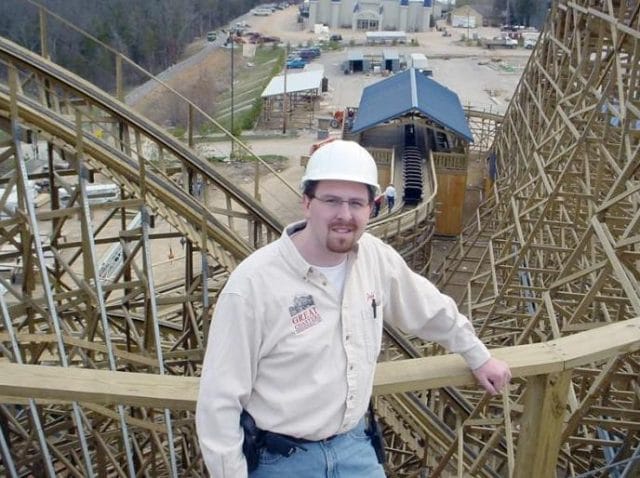
Jeff Pike atop Ozark Wildcat in Missouri; Source: GCI
At GCI, he spends about half his time drafting up new proposals, layouts, and theme concepts. The other half, he says, is “split between traveling the world trying to sell rides and doing the greasy, dirty work of putting cars together on the tracks.”
Sometimes, Pike jokes, inspiration for a new design will comes from an unexpected source:
“Once, we were drawing in the office, and a People magazine lying around had a picture of Jay Leno. We followed his hairline and chin to plan one of our coasters in Holland.”
While some modern contemporaries “consider wooden coaster archaic” in an age of steel, Pike stands by his creations: “they’re like nice pieces of framed artwork in a museum of technology,” he says. “They stand out because they seem so anachronistic.” The average wood coaster he designs requires about 50 truckloads of lumber, and the expertise of skilled carpenters and engineers.
The Cultural Impact of Roller Coasters

Source: Teo Barker
In American lexicon, the roller coaster has become a cliche for both a rocky experience, and an enjoyable journey. Coasters are referenced by everyone from Avril Lavigne (“Life is like a roller coaster — live it, be happy, and enjoy life”), to Rush Limbaugh (“I have to tell you, every day is a roller coaster”), and are inextricably linked with the variance of human expression.
This was noted as early as 1928, when cultural critic Siegfried Kracauer sat at the base of a German roller coaster and observed its emotionally-conflicted passengers. “It almost seems as if everybody is screaming because they imagine themselves safe at last,” he wrote. “With a cry of triumph: ‘Here we are, borne aloft in beatitude, zooming ahead in a race that may imply death, but also appeasement.'”
A conceptual coaster that has never been built (and hopefully never will be) artfully expressed this duality. In 2010, Julijonas Urbonas, a student at the Royal College of Art in London, conceived the Euthanasia Coaster, a steel coaster designed to “take lives with elegance and euphoria.” The concept calls for a 500-meter descent at 220 miles-per-hour which leads straight into seven consecutive loops (clothoid inversions). Hypothetically, the coaster’s passengers would die of cerebral hypoxia (lack of oxygen to the brain) after the first or second loop.
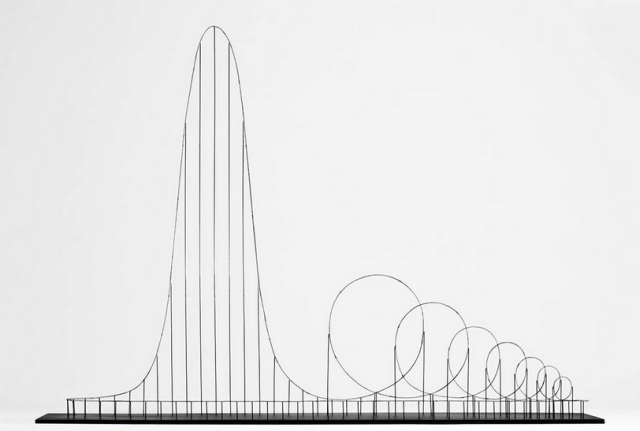
Euthanasia coaster (scale model); via Julijonas Urbonas
The concept — purely artistic (we hope) — aims to show the “future of humans and technology,” but also stresses the sadist nature of coasters: we enjoy suffering, just as we relish the uncertainty of what lurks beyond the peak of a hill.
Dr. Seymour Epstein, a psychologist at the University of Massachusetts, likens the roller coaster experience to skiing:
“’If you ask accident-prone skiers if they are scared when they are on a high-risk slope, they’ll say they wouldn’t bother to ski the slope if they weren’t scared. They want a slope that terrifies them…it makes you feel very alive to be so scared. When you react to something that demands your full attention so forcefully, all your senses engage.”
For all the advancements and iterations roller coasters have gone through since the ice sleds of 17th-century Russia, the end result is still the same: they evoke our primal desire to feel alive, to skirt the edge of comfort, to twist, turn, and tumble through the spectrum of human emotion.
But most of the time, in the words of John C. Allen, “they’re just damn fun to ride.”
This post was written by Zachary Crockett. Follow him on Twitter here, or Google Plus here.




